Development of a two-sided electron beam splitter published in Applied Physics Letters
In our latest publication, we demonstrate that we can divide an electron beam with much higher energy than previously possible into two beams by using a double-layer microwave structure. The working principle of this electron beam splitter is based on the fact that the movement of charged particles in a pure alternating electric field can also be described as the movement in an effective potential for comparatively high frequencies. The electron beam is divided by smoothly dividing the transverse pseudopotential minimum, into which the electrons are injected, along the structure into two minima. The electrons follow the evolution of the pseudopotential from a single-well into a double-well and are divided into two electron beams. The single-layer predecessor structures worked for electron energies of up to 4 eV, which was extended to 200 eV by the use of two microwave substrates aligned to each other. The improvement by almost two orders of magnitude can be explained by the different geometry, because the double-layer structures have much larger geometric factors for the calculation of the trap frequency and the pseudo-potential depth than the corresponding single-layer structures, which enables the guiding and splitting of a much higher-energy electron beam.

